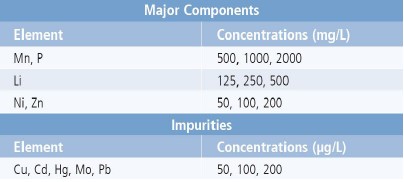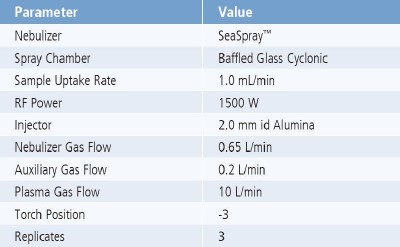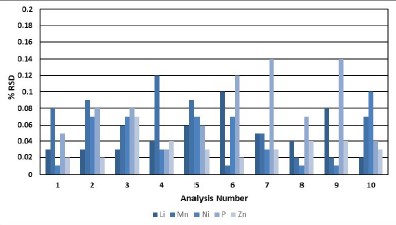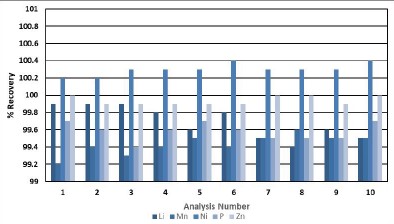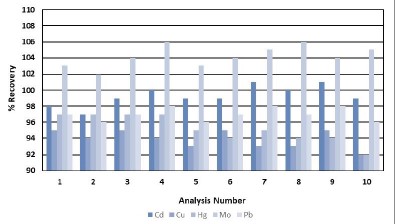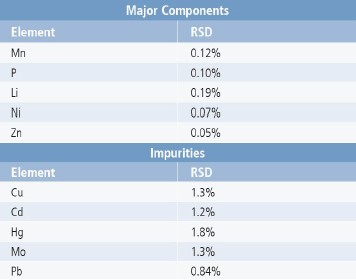Introduction
The use of batteries is growing rapidly as new uses are found, including providing power for anything ranging from consumer products to medical devices to automobiles. Additionally, with the growing use of alternative energy sources, batteries are required to store excess energy and release it when needed.
As a result of this rapid and varied demand, new battery types, technologies, and materials are continuously being developed. Some commonly-used elements in different types of batteries include lithium(Li), manganese(Mn), nickel(Ni), phosphorus(P), and zinc(Zn), among others. The percentage of these components can range from single digit percent up to 30%, depending on the battery.
An important factor in obtaining optimum performance is accurately knowing the ratios of the major components since deviations can negatively affect battery performance, as can the presence of impurities. Therefore, the major components must be measured both with high accuracy and precision, while, at the same time, measuring impurity levels.
ICP-OES is the ideal analytical technique to meet these needs: it has a high tolerance to matrices, yet is capable of high precision and can accurately measure impurities down to the μg/L level. The key to obtaining the highest possible precision with ICP-OES involves using a technique called continuous real-time simultaneous internal standardization(CRTSIS), in which internal standards are measured at the exact same time as the analytes they are associated with.1 CRTSIS can only be accomplished with a truly simultaneous ICP-OES, such as PerkinElmer’s Avio® 500.
This work demonstrates the Avio® 500 ICP-OES’ ability to measure elements commonly found in batteries with both high precision and accuracy while, at the same time, measuring common impurities.
Experimental
Materials and Sample Preparation
To mimic a digestion of battery materials, standards containing Mn, P, Li, Ni, and Zn were prepared at the concentrations shown in Table 1 in 2% nitric acid(v/v). In addition, common impurities were also added to the solutions containing the major components at the concentrations in Table 1. All the concentrations shown in Table 1 simulate a 100x dilution of starting materials used in batteries. Scandium(Sc) was added to all solutions as an internal standard.
Instrumental Parameters
All analyses were carried out on the Avio 500 ICP-OES using the parameters shown in Table 2; the wavelengths, plasma views, and timings are shown in Table 3. For optimum precision with CRTSIS, the internal standards are read with the same integration time as the analytes. The precision was further increased by using a 10-second read time, which allowed more readings to be acquired. The majors were measured against linear bracketing calibration curves, while the impurities were measured with linear-through-zero regressions; all calibration standards were prepared in 2% HNO₃.
Results and Discussion
Calibration curves were constructed, and the middle standard was measured 10 times against the calibration curve. Figure 1 shows that the relative standard deviations(RSDs) for all the major elements in all of the samples was less than or equal to 0.2%, with the majority of results being < 0.1%. This type of precision is only possible when the internal standard is read at the same integration time(0.01 sec) at the exact same time as the analyte. By having true simultaneous measurements, the internal standard corrects for shot and flicker noise, resulting in exceptional precisions.
Table 1. Elements and Concentrations.
Table 2. Instrumental Parameters.
Figure 1. Precision(%RSD) for major elements during 10 analyses of the middle calibration standard
(Mn, P=1000mg/L; Li=500ppm; Ni, Zn=100ppm).
Table 3. Method Parameters.
During the same analysis, the concentrations of both the majors and impurities were measured, with the recoveries for the majors shown in Figure 2 and the impurities in Figure 3. The major elements recovered within 2% of their expected values, while the impurities recovered within 6%.
The stability of the methodology is evidenced by the precision of the 10 analyses of both the major and impurity elements. As shown in Table 4, the RSDs of the major elements is less than 0.2% and less than 2% for the impurity elements.
This reproducibility for the major elements is only possible with the use of CRTSIS. The precision for the impurities demonstrates that both CRTSIS and “normal” analyses can be implemented within the same method without sacrificing data quality.
Figure 2. Recovery of major elements over 10 analyses(Mn, P=1000mg/L; Li=500ppm; Ni, Zn=100ppm).
Figure 3. Recovery of minor elements(0.1mg/L) over 10 analyses.
Table 4. Precision(% RSD) over 10 Analyses of Major and Impurity Elements.
Conclusion
This work demonstrates the ability of the Avio 500 ICP-OES to provide extremely high precision using continuous real-time simultaneous internal standardization(CRTSIS), made possible only with truly simultaneous measurements of the analytes and internal standards.
This ability provides real-time corrections of variations in the analytical signal, resulting in high precisions/low RSDs(typically < 0.10%). Because CRTSIS can be implemented in the same method along with analytes measured conventionally, both matrix components and impurities can be measured together in a single method, as shown in the analysis of matrix components and impurities in common battery materials. When combined with bracketing calibrations, CRTSIS provides both exceptional precision and accuracy in the measurement of matrix materials.
PerkinElmer의 'High-Precision Analysis of Battery Materials with the Avio 500 ICP-OES'에 대한 궁금한 내용은 본 원고자료를 제공한 한국퍼킨엘머를 통하여 확인할 수 있다.
Rerference(참고문헌): 1. “Continuous Real-Time Simultaneous Internal Standardization: Using the Avio 500 ICP-OES to Achieve the Highest Possible Precisions”, Technical Note, PerkinElmer, 2019.
Model Name(모델명): Avio 500 ICP-OES
The Person in Charge(담당자): Kim Wang-yu
Maker(제조사): PerkinElmer
Country of Origin(원산지): U.S.A
e-mail: Wang-Yu.Kim@perkinelmer.com
Data Services(자료제공): PerkinElmer Korea



